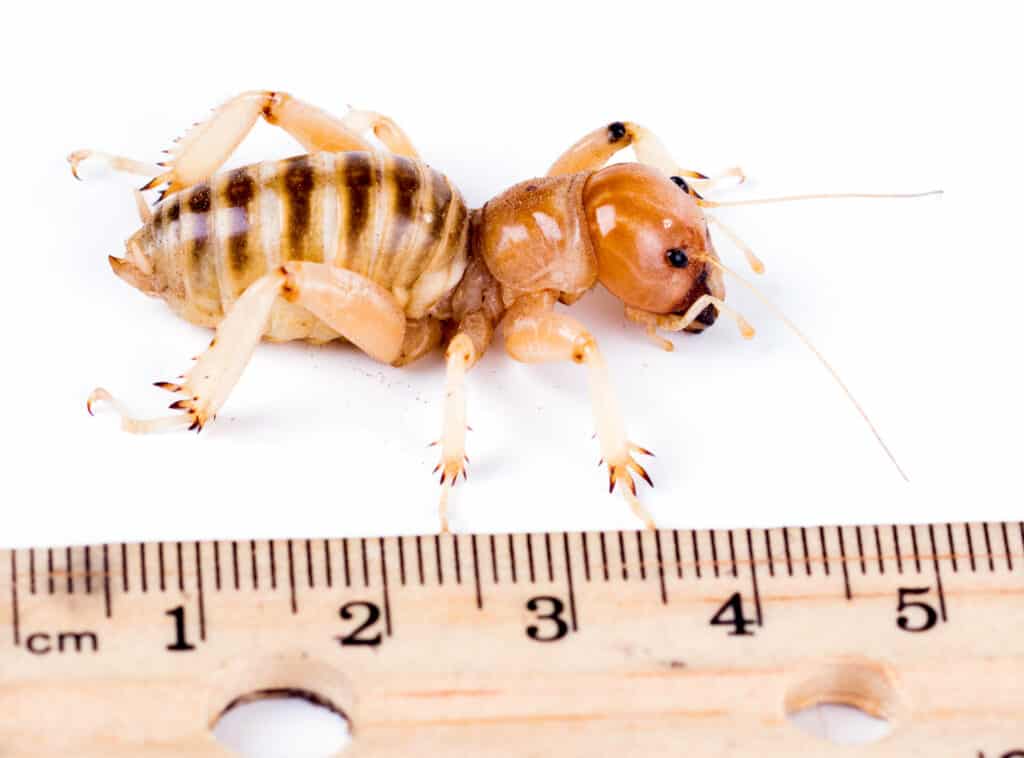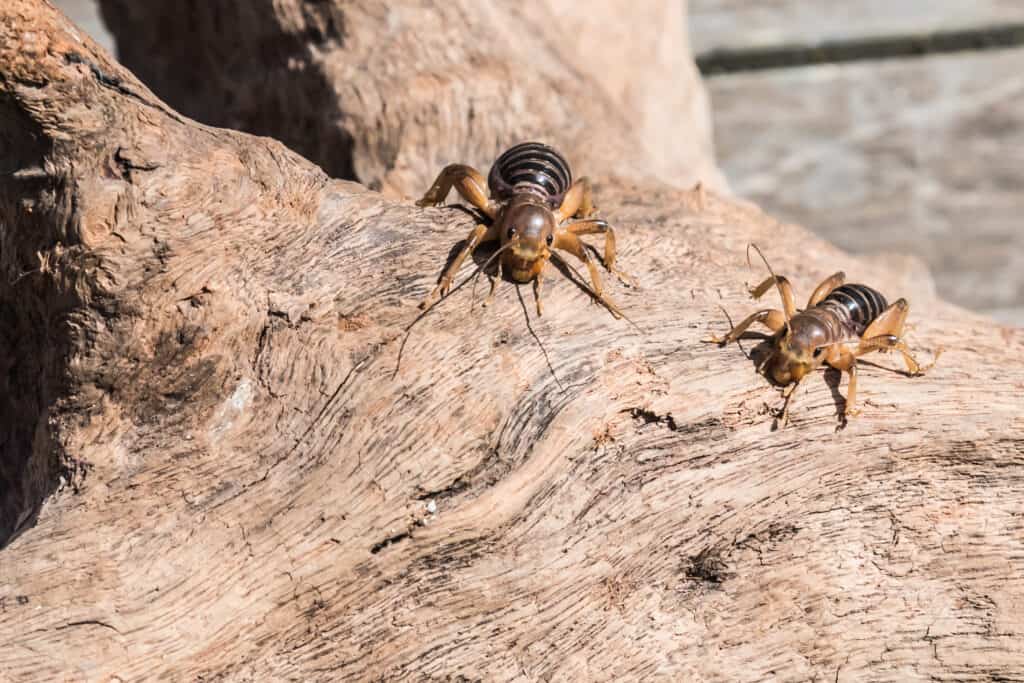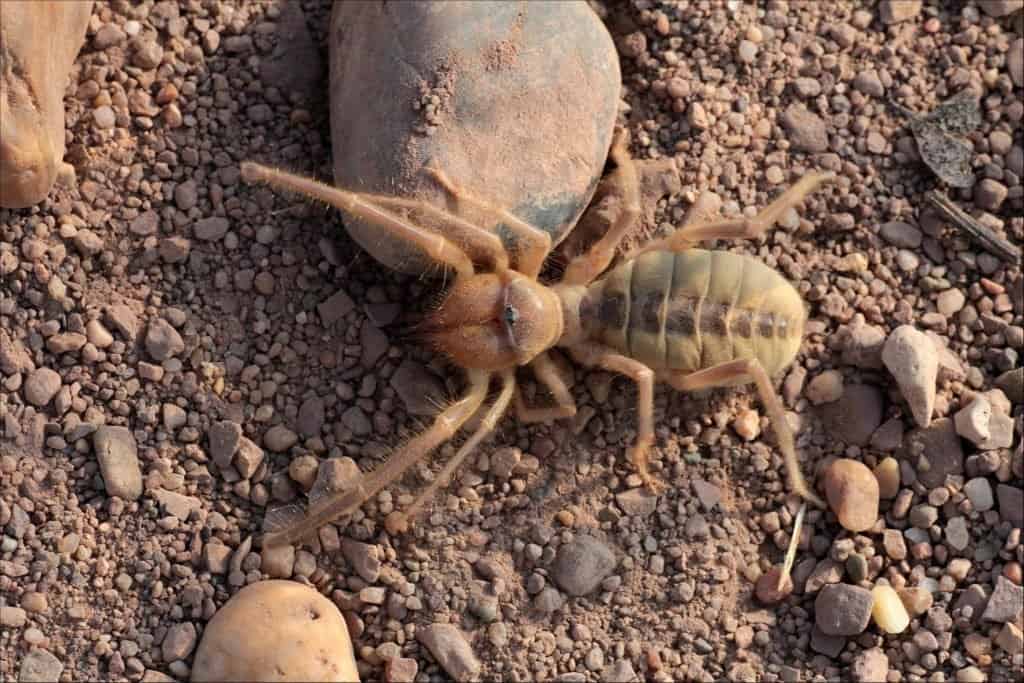Jerusalem crickets and camel spiders are two different creatures that people mistake for one another on occasion. Because people confuse the two, this article compares the Jerusalem cricket vs. camel spider to help you understand their unique features and what makes them different. Additionally, you will learn what they eat, their size, their distribution worldwide, the lifespan of these two invertebrate species, and other intriguing facts.
Comparing Jerusalem Cricket vs. Camel Spider
| Jerusalem Cricket | Camel Spider | |
|---|---|---|
| Scientific Name | Stenopelmatidae | Solifugae |
| Length | 2 inches | 1 inch |
| Identification | Six legs, a large round head with long antennae, and a stout, segmented body. | Eight-legged, somewhat scorpion-like, but lacking the tail. Elongated pedipalps. |
| Diet | Plant roots, other insects, decaying plant matter, and potatoes. | Invertebrates and small vertebrates; scavenge on dead creatures and hunt live prey. |
| Location/Habitat | Shallow soil burrows, often beneath rocks or logs. Cooler parts of western U.S. and south into Mexico. | Warm arid places like Asia, Africa, Middle East, Mexico, and the southwestern area of the US |
| Lifespan | Up to two years | Up to a year |
Jerusalem Cricket vs. Camel Spider: Identification

Jerusalem crickets generally measure 2 inches (5.08 centimeters) long.
©IrinaK/Shutterstock.com
The Jerusalem cricket is a nocturnal insect and is considered a “true bug” because they have piercing/sucking mouthparts. These insects are brown or yellowish with three distinct body segments – the head, thorax, and abdomen — and six legs. Their heads are large and rounded, with two black antennae. Their abdomens are also large and round, while their thoraxes are narrower.
On the other hand, the camel spider is not an insect but rather an arachnid. This classification means the camel spider has eight legs instead of six like the Jerusalem cricket. They also have two main body segments —the cephalothorax and abdomen — instead of three like the Jerusalem cricket. These spiders get their name from their long, camel-like legs, which can grow to double their body’s length. They are generally light brown or tan with dark brown markings on their bodies. Their abdomens have an oval shape with a pointy end, while their cephalothoraxes are round with two distinct eyes.
Jerusalem Cricket vs. Camel Spider: Names
Some people also call the camel spider a wind scorpion or sun spider, but these names are misleading, as the creatures are not closely related to either scorpions or spiders. However, they do resemble both groups and can look as vicious. For example, camel spiders have eight legs like a spider but have two long, curved fangs like a scorpion.
In contrast, Jerusalem crickets get their names “potato bug” and “sand cricket” from their diet of potatoes and other vegetables and their habit of living in burrows underground. Their historical names include “Child of the Ground” or “Child of the Earth.”
Survival Abilities and Environment
Jerusalem crickets and camel spiders are unique creatures known for their distinctive abilities. Camel spiders are quick and agile, which allows them to chase down their prey. In contrast, Jerusalem crickets are relatively slow-moving and tend to stay hidden in dark places. In addition, camel spiders and Jerusalem crickets have unique adaptations that help them survive in their respective environments.
Camel spiders live in hot, arid desert regions and use their speed and agility for hunting down insects and other small animals. In contrast, Jerusalem crickets live in cooler, moist environments and use their camouflage to escape the notice of larger predators.
Feeding Habits

A camel spider is far more ferocious in its hunting and feeding habits than the Jerusalem cricket.
©iStock.com/Willem Van Zyl
Jerusalem crickets and camel spiders are arthropods that share similarities in their diet and feeding methods. However, there are also some unique differences between the two. Jerusalem crickets primarily feed on plant roots and tubers, using their strong mandibles to cut into the flesh of their prey. However, they will also feed on other insects, including their own kind.
In contrast, camel spiders primarily feed on other insects and spiders. Once they catch their prey, they use their chelicerae to crush them before sucking out the body fluids. They then eat some of the fine particles before discarding the larger pieces. As a result, while Jerusalem cricket and camel spiders can cause damage to plant life, camel spiders are more likely to threaten other insects and spiders.
Jerusalem Cricket vs. Camel Spider: Life Cycles

Jerusalem crickets take two years to mature.
©David A Litman/Shutterstock.com
While Jerusalem crickets and camel spiders have three stages in their life cycle – egg, nymph, and adult – they differ in how long it takes to reach maturity. Jerusalem crickets take two years to mature, while camel spiders need eight instars before reaching sexual maturity. An instar is an interval between molts.
In addition, camel spiders live much shorter lives than Jerusalem crickets, with an average lifespan of just one year. Despite these unique differences, both arthropods must periodically shed their exoskeleton to grow.
Camel Spider vs. Jerusalem Cricket: Size
In contrast to the relatively small size of most camel spiders, some African species can reach up to 2.5 inches in length. Similarly, the largest specifies of Jerusalem cricket in the western U.S. reach over 3 inches in length.
The Jerusalem cricket and the camel spider are distinctive creatures with some key differences. Most notably, the Jerusalem cricket grows to about 2 inches as an adult, while the camel spider generally only grows to 1 inch long.
Location and Habitat

Jerusalem crickets vs camel spiders – despite many differences, both burrow in the ground in very different environments.
©Dmitry Fch/Shutterstock.com
Another difference between Jerusalem crickets and camel spiders is their habitat. While camel spiders live across Africa, the Middle East, and Asia, Jerusalem crickets primarily inhabit the western U.S. and Mexico.
Jerusalem crickets and camel spiders are arthropods that inhabit burrows in the ground. However, there are some significant differences between the two species. Jerusalem crickets live in shallow soil burrows, often beneath rocks or logs. On the other hand, camel spiders live in warm, arid places, primarily deserts and sandy areas, but you can also find them in forests and grasslands.
Up Next
- Black Widow Spider vs. Brown Recluse Spider: 5 Differences
- Is a Snail an Insect, Bug, or Something Else?
- Centipede
The photo featured at the top of this post is © Dr.MYM/Shutterstock.com
Thank you for reading! Have some feedback for us? Contact the AZ Animals editorial team.






